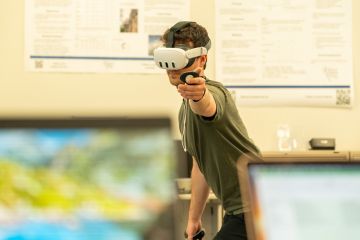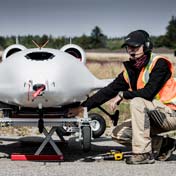Ancient technology, meet the future of underwater archeology
At first, the idea was a futuristic pipe dream. It popped into Dr. Quentin Mackie’s head while the University of Victoria researcher was attending a conference on underwater archeology and the first peopling of the Americas.
One day, he thought, archeologists might be able to operate an autonomous underwater vehicle (AUV) equipped with sonar imaging technology that could “fly”’ along the ocean bottom, searching for evidence of ancient coastal civilizations drowned when sea levels rose by as much as 150 metres at the end of the last ice age.
Fast-forward just six months and, with UVic mechanical engineer Alison Proctor and her department’s 3.5-metre long, $1.5-million Bluefin Robotics AUV, and supported by a Parks Canada research vessel and crew, they may have made one of the oldest archeological finds in Canada.
Mackie and Proctor just returned this month from a 10-day research trip to Gwaii Haanas National Park Reserve, at the southern end of the Haida Gwaii archipelago, a marine and terrestrial protected area managed cooperatively by the Government of Canada and the Haida Nation, and the site of most of Mackie’s life’s work. The trip yielded 150 gigabytes of sonar data and what looks like (he’s not calling it evidence yet) images of stone fish weirs, a simple and ancient technology used by peoples all over the world to catch migrating fish in rivers. If further investigation by a seafloor geologist rules out a natural explanation for this line of boulders 122 metres underwater, their find will also provide further evidence of the human occupation of Haida Gwaii at a time of extreme environmental change.
“It is a very emotional experience,” Mackie said, “to look at these images and think that what we might be looking at is evidence that people were living on this land and catching salmon before there was even a forest here, when it was still a grassland almost 14,000 years ago.”
Mackie will spend this fall and winter poring over scans and hopes to return with Proctor next summer to continue the project.
Proctor is the project’s technical lead and an expert in the use of AUVs in underwater archeology. She used the faculty of engineering’s AUV in 2012 in the search for the Franklin shipwrecks.
Sonar images, as well as video and still photos shot on location, are available on request.
-- 30 --
Media contacts
Quentin Mackie (Anthropology) at 250-721-7055 or qxm@uvic.ca
Alison Proctor (Mechanical Engineering) at 250-721-7297 or proctora@uvic.ca
Suzanne Ahearne (University Communications + Marketing) at 250-721-6139 or sahearne@uvic.ca
In this story
Keywords: technology, archeology, robotics
People: Quentin Mackie, Alison Proctor




